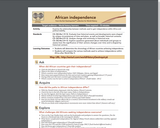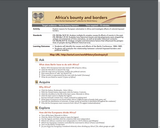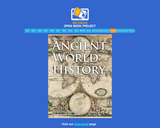
Students will use the study guide to help prepare them for a unit test.
- Subject:
- World History
- Material Type:
- Assessment
- Author:
- Mary Price
- Date Added:
- 05/16/2021

Students will use the study guide to help prepare them for a unit test.

This Ancient Indian Lesson Plan can fit a 1 or 2-week time frame. It focuses on the themes of Geography, Religion, Achievements, Politics, Economics, and Social Structure (G.R.A.P.E.S.). Included in this unit of study is a breakdown of relevant NC Essential Standards, concepts, and skills that match the lesson goals. Some goals will overlap, additional standards and goals can be added to lengthen the unit. Student learning objectives, engagement opportunities, accommodations, and assessment ideas are included.

In this culminating activity, students will use available items from the makerspace to create a new innovation to demonstrate the advancement (and superiority) of one of the countries involved in the Cold War. The learner will summarize the governments in conflict that lead to the space race and arms race during the Cold War.

In this online lesson, students learn about the causes and effects of the Reformation in Europe through various media.

In this online lesson, students are introduced to resources that will help them better understand the effects and implications of the reopening of the ancient Silk Road between Europe and China, including Marco Polo's travels and the location of his routes.

Students will create a digital presentation of their topic. Areas highlighted will be Human-Environment Interaction, Politics, Economics, Culture (to include Religion) and Technology. Students will also discuss the important points of the previously created timeline.

In this lesson, students will participate in a concept formation lesson designed to teach them an understanding of the concept absolutism. In order to develop comprehension of the concept, students will uncover the critical attributes of absolutism from analsyis of a series of examples and non-examples. Students will learn about the absolute monarchies in power during the age of enlightenment and examine contemporary examples. In the process of identifying the concept, students will also understand the similiarities and differences of constitutional monarchies and totalitarianism.

This article explains the development and legacy of the Achaemenid Persian Empire.

This article explains how Christianity was adopted in Ethiopia in the fourth century. It also explains how Askum's geographic location played an important role in the development and spread of Christianity in this region.

This article examines the spread of Christianity in Kongo. It explains why the Kongolese adopted the religion and its impact.

Examine the relationship between methods used to gain independence within Africa and political stability.

Explore reasons for European colonization in Africa and investigate effects of colonial-imposed borders.

A website resource that provides facts and data that documents the forced removal of enslaved persons from Africa and their arrival to North Carolina.

Students will explore the Age of Enlightenment through a Power Point presentation and class discussion. Students will then further explore this period of history and its prominent figures by designing a dinner party for 12 Enlightenment thinkers. This project will encourage students to learn more about the period and the philosophers associated with it, as well as synthesize what they have learned while utilizing higher order thinking, group work skills, and creativity.

Students will explore the Age of Enlightenment. Students will then further explore this period of history and its prominent figures by designing a dinner party for 12 Enlightenment thinkers. This lesson will encourage students to learn more about the period and the philosophers associated with it, as well as synthesize what they have learned while utilizing higher order thinking, group work skills, and creativity.

This article assesses the impact of this agrarian revolution. From the 16th century onwards, an essentially organic agriculture was gradually replaced by a farming system that depended on energy-intensive inputs.

In this lesson, students examine the relationships between and among powers inside and outside Afghanistan in connection to United States military aggression in the territory.

This is the news article which is attached to the lesson plan of the same name.

Seventh grade students will review the tools and mental constructs used by historians and geographers. They will develop an understanding of Ancient World History, Eras 1 – 4. Geography, civics/government, and economics content is integrated throughout the year. As a capstone, the students will conduct investigations about past and present global issues. Using significant content knowledge, research, and inquiry, they will analyze the issue and propose a plan for the future. As part of the inquiry, they compose civic, persuasive essays using reasoned arguments.

Few geo-political events have resonated through the past 70 years like Neville Chamberlain?s decision to pursue the policy of appeasement in reaction to German aggression leading up to the Second World War. Leaders throughout the world have invoked appeasement to justify military action ever since. The decisions that went into Chamberlain?s policy, however, were far from straightforward. Historians have continually debated and reinterpreted these events. In this lesson, students address the issue of appeasement and explore and weigh evidence against and in favor of the policy.